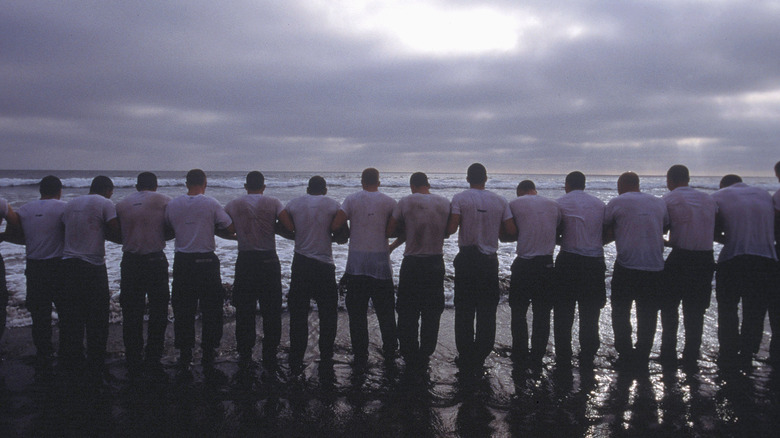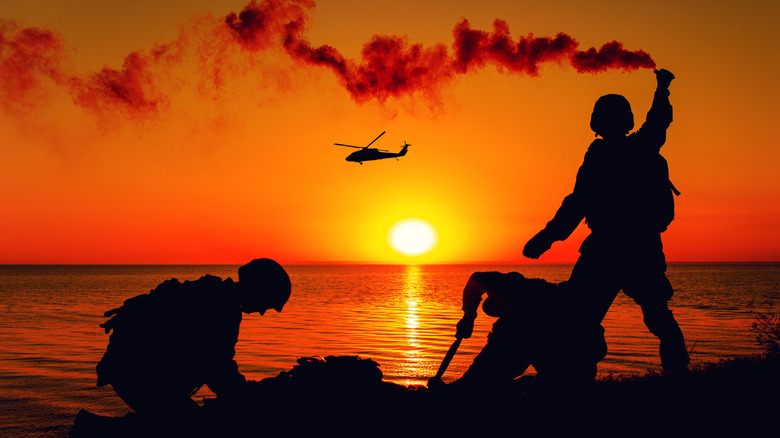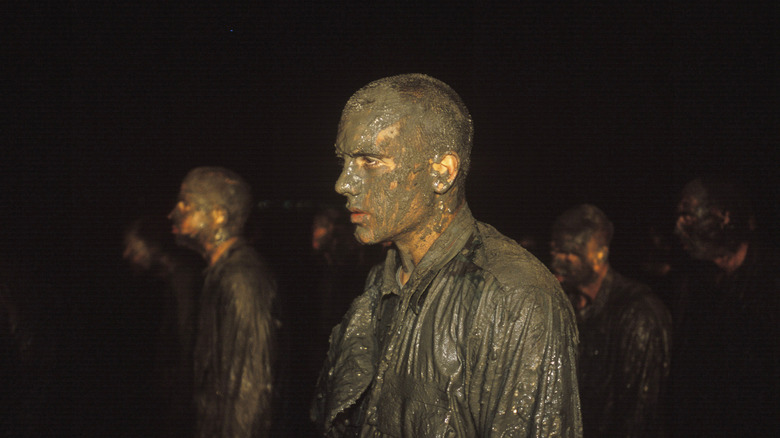How Many Navy SEALS Have Died While Training?
It is often said that men and women in the armed forces, in offering their will and their lives to the line of fire, make the supreme sacrifice. It's a matter of life and death, and soldiers seldom forget it. However, misfortune and fatality aren't always restricted to the battlefield. According to USA Today, more Navy SEALs died in training between 2013 and 2016 than in combat or from combat-related wounds. Those numbers are representative of just how intense and astoundingly dangerous training for SEALs really is.
On February 4th, 2022, Navy SEAL candidate Kyle Mullen tragically lost his life during the "Hell Week" segment of SEAL training. He and another candidate were hospitalized within hours after finishing their Basic Underwater Demolition class, or the SEAL (BUD/S) class, per Yahoo! News. According to Military, this is the first of three phases of BUD/S training and "includes continuous physical conditioning."
The two soldiers were rushed to nearby medical facilities. While one is reported to be in stable condition, Mullen died in a San Diego hospital last week. "We are extending every form of support we can to the Mullen family and Kyle's BUD/S classmates," Rear Adm. H.W. Howard III, the commander of Naval Special Warfare Command in Coronado and California, shared with reporters (via Yahoo! News).
The circumstances of Mullen's death are still under investigation. Most recently, in 2016 Seaman James "Derek" Lovelace died during a BUD/S pool training, and according to NBC News, three other SEAL candidates died during the four training classes prior to Lovelace's.
Origins of the Navy SEALs' rigorous training
The origins of the highly elite and exclusive Navy SEAL branch of the military stretches back to World War II. When the U.S. was faced with accelerated and unprecedented warfare from new enemies overseas, it found itself in need of something accelerated and unprecedented within its own ranks.
According to Navy SEAL Museum, the first-ever training project on record took place in Norfolk, Virginia in 1942 when America was gearing up for an Allied invasion of North Africa (Operation TORCH) in November of the same year. This specific group of soldiers at that time were called the Amphibious Scouts and Raiders (S&R). Recruits within this military faction were trained for reconnaissance, prospecting landing beaches, and leading assault forces to the correct beaches covertly and under cover of darkness.
Moving forward, the new sect of soldiers would be highly instrumental in missions like D-Day (The Bloody Sands of Normandy) and The Invasion of Southern France. It's tough to say whether or not World War II would have ended the way it did without them. The maritime tactics coupled with rigorous, boots-on-the-ground stamina helped forge what is now the platform for all Navy SEAL training and protocol (per Navy SEAL Museum).
That intense training has evolved to what is referred to as Hell Week today, which SOFREP (Special Operations Forces Report) describes as a "gut check" for candidates. It's five days and a half days of pushing yourself to the limit, and for some, beyond their limits.
Only 1 in 5 SEAL candidates complete the training
Hell Week as described by SOFREP means a total of four hours of sleep during those five days, along with enduring "hypothermic waters, and of course, a lot of sand. The website calls the training, "inherently dangerous."
SEALS stands for "Sea, Air, and Land Teams," and recruits are prepared to jump out of a helicopter into enemy territory one day and take on an underwater tempest another — two hands of the same body (per Navy). It's ferociously demanding and uncompromising work, and candidates have to prove they can make it through those few days to move on to the next phase of training.
Only one in five volunteers make it through the grueling segment of preparation, producing around 200 to 250 SEALs each year, according to NBC News. While the exact number of deaths throughout the entirety of Navy SEAL training remains undisclosed, applicants looking to join the elite sect of the U.S military are forewarned of the risks involved.
Per SOFREP, risks during Hell Week include rhabdomyolysis, or a break down of muscle tissue, and Swimming Induced Pulmonary Edema (SIPE), which happens when blood escapes the vessels in one's lungs and gets into the breathing cavity, causing severe coughing which can be accompanied by spitting up blood.
Since 2001, as many as 17 candidates have died while taking on the strenuous obstacles that substantiate Navy SEAL training (via NBC News). According to SOFREP, that year is also when SEALS stopped working in regional teams to instead "share global warfare."


